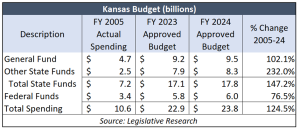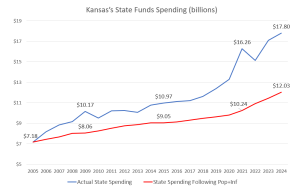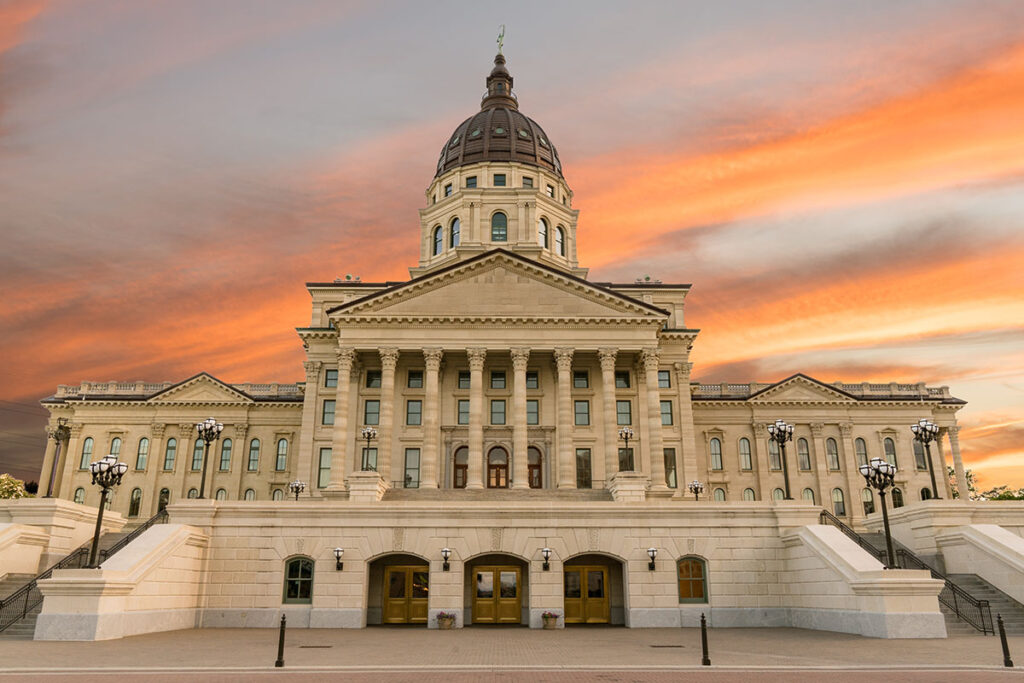Kansas will set more big spending records this year, with a total budget of $23.8 billion. That includes about $6 billion in federal funds and a record $17.8 billion in state funds.

State fund spending will increase by about $700 million this year and total spending will be $900 million higher than the final approved budget last year.
The Kansas appropriations were distributed via multiple bills, a fairly typical occurrence in Kansas: SB 113, which covered the Education appropriations, and HB 2184 and SB 25, which covered the rest of the budget. There’s a layered effect of 2022’s HB 2567 and Governor Laura Kelly’s line-item vetoes on SB 113 too. Information about the budget was confirmed by KPI with the Kansas Legislative Research Department (KLRD).
While the official amount of federal funding that Kansas is set to receive for FY 2024 is not yet publicly available, KLRD says the best estimate is from the Governor’s Recommended Budget from February 2023, where the Governor recommends $6 billion dollars total.
State spending this year will be about $400 million below the limit established by KPI’s Responsible Kansas Budget, which recommends that spending not exceed the combined rates of inflation and population. Kansas’s State Funds Budget over time is represented in the below graph sourced from KLRD, the Kansas Division of Budget, and the St. Louis FRED.

The Kansas Responsible Budget recommended a cap of $18.2 billion in State Funds based on a 6.58% increase from 2023 appropriations (7.18% for inflation and -0.60% for population).
While spending this year is below our RKB, it could be much lower. In FY 2021, 132 state programs whose budgets totaled to $815 million had declining outcomes based on the state’s performance-based budgeting metrics. 65 other programs didn’t report any performance measures at all despite receiving state funds. Every dollar that’s spent with no oversight could be wasted, or be better off in the taxpayer’s pocket.
Spending control often raises the specter of cutting services, but it can be accomplished by reducing the cost of providing services. Former Indiana Governor Mitch Daniels accomplished an 11-year tuition freeze as President of Purdue University. His successful strategy in keeping a balanced budget is a continual process of targeting and eliminating waste across the University. Daniels famously said, “This place was not built to be efficient. [But] you’re not going to find many places where you just take a cleaver and hack off a big piece of fat. Just like a cow, it’s marbled throughout the enterprise.” This type of behavior is why performance-based budgeting originated: to find what’s working and what isn’t and see what can be done better.
Within hundreds of different programs and initiatives scattered across the enterprise of state government, there unquestionably is room to reduce unnecessary spending, as some states are already doing it. In 2021, the states with an income tax spent 80% more per resident than the states without an income tax. Every state provides the same basic basket of services, but some do so much more efficiently and pass on the savings in the form of lower taxes. 132 state programs spending $815 million in FY 2021 had declining performance outcomes or no outcomes reported at all.
Kansas’s budget certainly is like a huge slab of marbled meat with inefficiencies, lack of oversight, and opportunities for saving across every program. But by making the effort there is how budget creep can be stopped and the burden on ordinary families can be lessened.




